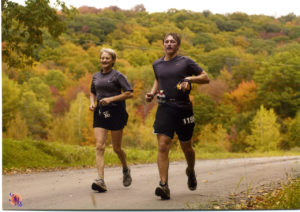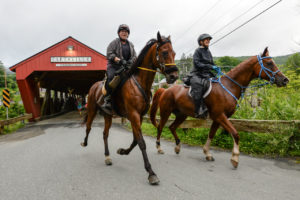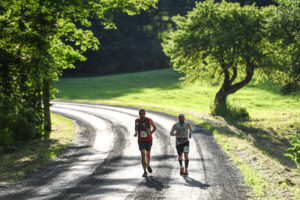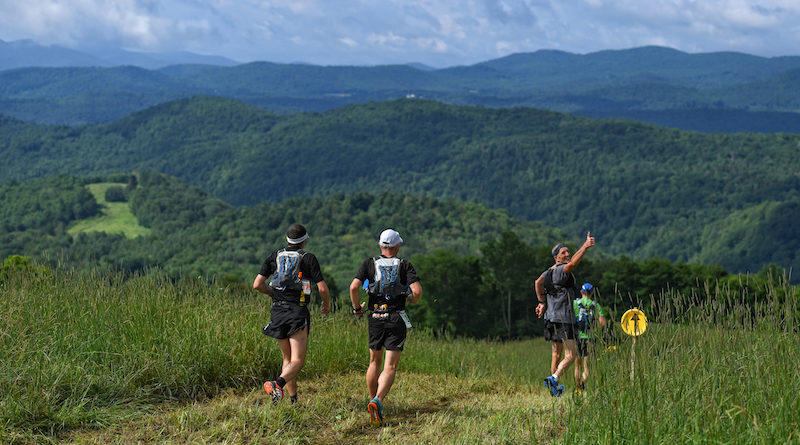The Vermont 100: An Ultra Pioneer
It may have seemed crazy at the time, but 30 years later the Vermont 100 has become one of the country’s most legendary and enduring ultra races. Photos by Ben Kimball
It’s 4:30 a.m. and somewhere in the woods in central Vermont nearly 350 people are running in the dark. The route, barely marked, weaves in and out of dirt roads and then hits a trail. At Mile 7 the first hill rises, a climb up Dunsmore. At Mile 11, there is another. Then comes the classic covered bridge, Taftsville, at Mile 15.4.
At this point, runners are still smiling and the horses are fresh. Everyone is in a good mood as the rising July sun starts to warm the dirt and clouds nestle in the valleys between the green rolling hills. It’s only six more miles to Pretty House, and if you can make it there by 10:30, you’ve made it to the first cut-off and the first fifth of the race. Only 79 more miles to go.
The Vermont 100 is not your average ultra race. There is no map available ahead of time as much of the route crosses private land that’s only open during the event. The shamrock- shaped loop of a course consists of 8 miles of rolling dirt roads, 30 miles of horse trails, 2 miles of pavement and 17,000 feet of total ascent.
To even compete, participants have to complete at least 8 hours of service, volunteering at a trail event or doing trail maintenance. The race is capped at 350 and to qualify, you must have completed a 50-miler in under 12 hours. You agree to medical checks at aid stations and can be pulled from the race if you don’t pass. The time limit for runners finishing the 100-miler is 30 hours, and for riders, 24 hours.
Other than these strict rules, this ultra is about as fun as it gets. Aid stations take on personalities of their own, such as At Margaritaville, hosted by Vermont’s Frozen Fins, a loose society of Parrot Heads grills up “cheeseburgers in paradise,” blares Jimmy Bu et songs and serve margaritas (primarily consumed by volunteers and the equestrians.) The Breakfast Club dishes out pancakes and bacon. The Spirit of 76 (at Mile 76) is all about red, white and blue patriotism.
The Vermont 100 is also one of the oldest ultra marathons in the U.S. and one of five that comprise the Grand Slam of Ultra Running. Oh yes, and there are horses: this is the only known, ongoing ultra race in America where runners and horseback riders still compete on the same course.
But perhaps the most unusual thing about the Vermont 100 is its founder.

FROM 0 TO 100
“My first running race ever was a 100-miler,” Laura Farrell says with a laugh, “and I had to work pretty hard to persuade the race organizers to let me in.” An accomplished equestrian who had been riding since she was six, Farrell had raced the Old Dominion 100, an endurance ride in West Virginia in 1980.
At the time, the race was both a running and riding event. “I thought it would be fun to run it as well,” Farrell said. “I had no running credentials. You are supposed to qualify by running another race, but I persuaded the race organizers to agree that if I could run 50 miles on my own, they’d let me enter the Old Dominion 100.”
Two years later, in 1982, she did. She not only won the Old Dominion 100 but became the first woman to have competed in the 100 as a both a rider and a runner.
“I think because I was so in tune to understanding my horse’s body, I listened to my own. I thought about hydration and eating and resting,” Farrell recalls. “It was so much fun,” she says with gusto.
The word “fun,” is a staple in Laura Farrell’s vocabulary and her approach to life. At 66, with a bob of blond hair, piercing blue eyes and a compact, athletic build, she looks as if her battery level never drops below full. “When Laura wants to do something, you can be pretty much sure it’s going to happen,” says her husband Jim, a ski coach at Mount Mans eld Academy.
The two met at Ascutney where Laura had been teaching skiing and was trying to put in wheel-chair accessible ramps. Jim was in construction and helped out. He’d grown up in Windsor on a farm, went to University of Vermont where he ski raced and became a baseball star (he’s in the UVM Hall of Fame). The ramp was part of Laura’s mission to make skiing accessible to everyone.
“I had started teaching skiing to a family whose middle daughter had Down syndrome,” she recalls. “I was determined to teach her to enjoy skiing just as much as the rest of the family and she actually became quite good.”
That was, Laura says, the turning point in her life. “That was the ‘aha moment’ that made me launch Vermont Adaptive Ski & Sports.” Today, it’s one of the leading organizations in New England in getting people of all abilities involved in sports that range from skiing to sailing.
Farrell had competed in the 100-mile endurance ride that had been held in Woodstock, Vt. in the 1970s and early 1980s but had faded away. In 1988, Woodstock’s Steve Rojek (one of the top competitors on the international equestrian endurance circuit) and his wife Dinah revived it and a year later, asked Farrell if she would help organize a running race alongside. Farrell saw it as potential fundraiser for her fledgling non-profit, Vermont Adaptive, and agreed. That year the race drew 114 participants and had 36 aid stations.
Later, the Vermont 100 added a 100-kilometer option, and then in 1993, Farrell went on to start a separate race, the Vermont 50 run and mountain bike race.
THE PROVING GROUND
The Vermont 100 became an instant alternate to Old Dominion as one of the qualifying events for the Grand Slam of Ultra Running, which also includes the Leadville (Colo.) 100, the Wasatch (Utah) 100 and Western States (Calif.) 100. Only one Vermonter, Bob Ayers, Jr., of Colchester, has officially completed the Grand Slam ( in 2013, at the age of 53).

For many others in Vermont’s elite running world, the Vermont 100 became a rite of passage on its own. Montpelier lawyer, triathlete and ultra runner Dot Helling became the first Vermont woman to win the race in 1997, finishing in 19 hours, 33 minutes. “I was thrilled at age 47 to have dueled it out with 30-year old Ellen McCurtin, a member of our National 100K Team,” she wrote after the event.
After winning, Helling threw out a challenge: she’d pay the entry fee for any Vermonter who won overall or won the men’s division. In 2004, Northeast Kingdom runner Susana Johnston won the women’s division in 17:40 and finished eighth overall. It wasn’t until 2013 that Helling had to pay out. At age 51, Charlotte runner Jack Pilla beat two 28-year-olds to win the race in 16:36:21, becoming (according to Ultra Running) the oldest winner of a major 100- mile run ever. At the time, Pilla’s finish was among the top 10 fastest times recorded for a major 100-miler.
Then, in 2014, Brian Rusiecki of South Deer eld, Mass., shattered the record, finishing in 14:47:35. “Brian had come within a minute of breaking the record two years earlier and was determined to do so,” says his wife Amy, also an ultra-runner who has raced six times, and finished second, once, and third three times among women.
“One of the things Laura is great about is building something up and then handing it o successfully so she can go on to do something else,” says Amy, who now is race director. Farrell rst handed the race over to local Vermont Adaptive supporter Jim Hutchinson. When he died suddenly after the 2008 race, his daughter Julia took over and then in 2015 Amy Rusiecki stepped up to run the event.
“It wasn’t so much that I wanted to be a race director, but I wanted the Vermont 100 to stay the same and keep its homey avor,” said Rusiecki. She had competed at Western States 100, an event she describes as “big and super competitive” and watched the Leadville 100 get bought by a corporation. “What’s di erent about the Vermont 100 is it is just fun,” she says. “People camp out at Silver Farm the night before and we do a big barbecue there after the race,” she says.
Rusiecki also recruited running clubs from around New England to volunteer to run aid stations and as they did, each upped theanteonfoodanddecorations.
After running with a friend whose vision is impaired, Rusiecki also started the rst division for athletes with disabilities. “We had people with disabilities run before – including Amy Palmiero-Winters (who holds the world record for a marathon for a female, below-the-knee amputee) and another guy who had to run on crutches,” she recalls.
“But we wanted to make it easy for others to race and lay out provisions for any special needs they might have. After all, this is all to benefit Vermont Adaptive.” In 2017, The Vermont 100 was the first ultra race to do so. Now, Rusiecki says, others are starting to follow suit.
IT TAKES A VILLAGE
If you ask Laura Farrell about the history of the race, she barely mentions who raced or won. Instead, she talks about a local farmer, Bill Stillson, whom she cajoled into setting up a truck on his farm with some water bottles as an “aid station,” early in the race’s history. “He set up a lawn chair and had no idea what to do when runners showed up and began lying down in the truck and opping in front of him,” she recalls. But Stillson was hooked. His daughter still volunteers and the farm is still the sight of “Bill’s” aid station.
Farrell talks about the competition between aid stations to be the most “fun.” And she explains what the race has meant to the community and to people such as Krista and Guy Alderdice, who rst came to Brownsville for the race and then moved there.

“In 2001, Guy and I were living in Jericho and drove down so I could ride in the Vermont 100,” Krista Alderdice says. “Those early years were amazing: the race started at Steve Rojek’s farm. There was a grand piano in the field playing the theme from “Chariots of Fire” at the start and reworks at 4:00 a.m. as the runners went off.” After that, the couple—and Krista’s mother, Melody Blittersdorf—started coming every year. Both Krista and Melody compete in riding events at a high level and were among 23 foreigners invited to Dubai to race the HH Sheikh Mohammed Bin Rashid Al Maktoum Endurance Cup, Krista on the Sheikh’s own horse.
In 2004, Krista was three months pregnant with her second son when she entered the Vermont 100 on her Morgan horse, Song, and won. “That was the best year,” says Guy. Two years later, the couple made the decision to move to Brownsville.
“The community here is amazing and the per capita number of endurance athletes that live here (probably because of this race), is incredible,” says Guy. “I was the person who used to laugh at runners, but after so many years as a support crew and saying ‘yeah, one day I’ll run this,’ I finally did. “When we moved here, we found it wasn’t unusual to get a babysitter, so we could both join in a 60-mile night run to a Dunkin Donuts in Lebanon and back with a bunch of buddies.”
Guy remembers when he finally decided to run. “I was at the starting line thinking, ‘I don’t belong here – I’m just a blue-collar runner.’ I think I was wearing Walmart socks and had no idea what I was doing.” Still, he remembers the feeling of coming into the Ten Bear aid station at Mile 70 to pick up his pacer. “It’s pitch dark and then you see all these sparkly lights and hear your name being called out. It was amazing.”
For Krista, the most memorable part of the course is coming into Bill’s aid station, located at a farm set in a field. “It’s classic Vermont with a barn and a view of Mount Ascutney right in front of you.”
In 2015, a kick from a horse shattered Krista’s elbow. “It definitely changed my mojo about riding,” she remembers. Instead, she started to run more and in 2017 ran the Vermont 100. “I finished an hour before the cut-off,” she says with mock pride.
This year, both Krista and Guy Alderdice will run – Krista’s tenth event (8 are on horseback) and Guy’s sixth.
“One of the things we’ve also both loved is that this event raises fund for Vermont Adaptive,” Krista says. “I’ve seen a woman running with a blade and I think to myself my injury could have been so much worse. The thing the Vermont 100 teaches you is the same message that Vermont Adaptive shares: Anybody can do anything they want to. It’s pretty incredible to watch.”


Pingback: Vermont Sports Magazine, May 2018